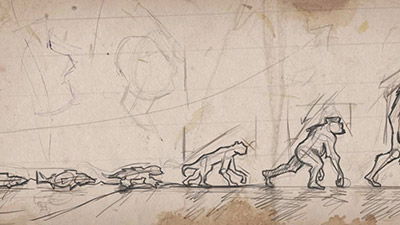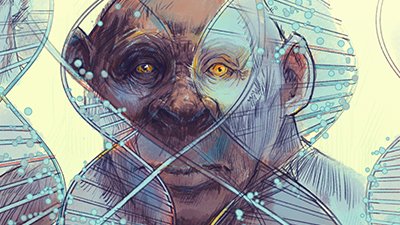
Is Sahelanthropus Our Seven-Million-Year-Old Bipedal Ancestor?
Could this purported human ancestor even walk upright?
A recent CNN news article1 came out which discussed a Nature journal article2 on Sahelanthropus tchadensis. Sahelanthropus was discovered at the Toros-Ménalla site in Chad (Africa) in 2001, and research of the remains has been ongoing. The site has been conventionally dated by cosmogenic nuclide (10Be/9Be) dating methods to be between 6.8 and 7.3 MY.3 So far, the dig site has revealed a nearly complete cranium, three mandibles, and several isolated teeth as well as a left femur and two ulnae. Although all of these fossils were discovered in 2001, only the cranium, mandibles, and teeth were initially described as belonging to up to five individuals of Sahelanthropus. It took several more years to identify and describe the femur and ulna fossils (beginning in 2017 and concluding in 2020). This 16–19 year lag time in describing these post-cranial fossils has itself been controversial, with many researchers calling such a delay “inexcusable.”4
The researchers took detailed measurements of all three of the arm and leg bones, focused on thickness, and used computed tomography scans to see their internal structure. The femur in particular was the most significant factor in the researcher’s claim that S. tchadensis was bipedal. They concluded that S. tchadensis likely spent some time clambering in trees but when on the ground usually walked on two legs, basing this on several features of the femur that they say are closer to those of modern humans than extant apes, which usually walk on four limbs. These features include the distribution and orientation of the thicker sections of dense outer bone layers, called the cortex, and the presence of a rough surface at the top of the femur where the gluteal muscles attach. Weight-bearing load and torsion modeling on the femur, as well as “a clearly identifiable structure” formed by dense cancellous bone—the calcar femorale (CF)—which also appears on human femurs, were all interpreted as a “mechanical support for load distribution within the proximal femur in relation to habitual bipedal locomotion.”5
Problems with the Fossil Site
But the authors of the paper (as well as previous authors) note that there are problems with the Toros-Ménalla fossil site in Chad. Starting in 2001 when the site was discovered, the left femur and two ulna bones were assigned to be from the same species as the skull found months earlier (and the mandible discovered later). But the authors of this recent paper admit, “Although none of these limb bones can be reliably ascribed to any hominin craniodental specimen found at TM 266, the most parsimonious hypothesis is to assign these postcranial remains to the sole hominin species so far identified in this locality: S. tchadensis.”6
If even one of the arm or leg bones, or the skull or mandible, belong to a species other than S. tchadensis, the results of the study are spurious.
Additionally, currently described remains assigned to S. tchadensis allegedly came from six to nine adult individuals from three fossil localities scattered across an almost half-mile radius (0.73 km).7 If even one of the arm or leg bones, or the skull or mandible, belong to a species other than S. tchadensis, the results of the study are spurious.
Problems with the Fossils
Not only is the fossil site itself controversial, so are the fossils themselves. When the skull was initially discovered in 2001, it was heavily damaged and described as “partly distorted from fracturing, displacement and plastic deformation.” In addition, its estimated endocranial volume (360–370 cm3) is more apelike than human, as is the mandibular dental morphology, and most importantly, the foramen magnum, where the spinal column connects to the skull (even for the digitally reconstructed skull), is within the range for bonobos.8
In fact, since the foramen magnum is the primary indicator of whether a creature is bipedal or not, to make such a determination without a pristine (non-distorted and undeformed) skull is speculative at best. Other researchers have commented on several aspects of the skull morphology, with one paper claiming the foramen magnum of S. tchadensis was forward of the third molar and thus would not allow for bipedality. Some have also said that the skull was likely that of a female gorilla or chimpanzee.9 Another paper claimed that bootstrap support for S. tchadensis as a basal hominin was low (only 41%) and that it could just as well be grouped with chimpanzees (Pan).10 Yet another paper claimed that the nuchal plane (the external surface of the occipital bone of the skull where muscles attach to the back of the neck) were chimplike, not human.
The TM 266 cranial rear and posterior portion of the cranial base, including the size, shape, and orientation, of the nuchal plane, are compatible with a chimpanzee pattern of locomotion. The nuchal plane is exceptionally long, and even with the greatly reduced nuchal angle of the reconstruction, its most posterior extent is markedly above the Frankfurt Horizontal. The prominence of the nuchal muscles, so important in head balance and loading, and shoulder movements, is enhanced by the significant development of the tuberculum linearum. The point is not that the TM 266 cranial rear and posterior portion of the cranial base was unlike hominids because the region looks like apes, but that TM 266 had a posture that is not upright because the region reflects nuchal functions similar to those of apes.11
The reconstruction of the skull seems to have been predicated on assuming bipedality, as the author of one paper questioned in the first published papers. “This [foramen magnum] alignment is important in the determination, but we have no information on how the Sahelanthropus position was assessed.”12 Another paper questioned how a determination on bipedality could be made when “the nature and relationships of S. tchadensis rely on morphological evidence from a distorted cranium, or from a virtually reconstructed version of that cranium.”13 Yet another noted that “the unreconstructed angle of the nuchal plane to the Frankfurt Horizontal is approximately 55° and the reconstructed value is 36°,” meaning that “the length, breadth, and many details of the nuchal plane are ape-like and not hominid-like.”14
Femur Follies
Regarding the left femur that was found, both ends are broken off, so the areas where the femur would connect to the tibia and patella (at the knee) and where it articulates with the acetabulum of the pelvis to form the hip joint are not present. Apart from the foramen magnum, these two areas (hip and knee) and how they articulate with the femur are the next-most important factors for determining bipedalism. And yet, even without these available (and with controversy surrounding the exact placement of the foramen magnum), the authors of the Nature journal article are (over)confident that S. tchadensis was bipedal based mainly on the femur:
Given the combination of hominin-like traits identified in this study (compared to Miocene apes and extant non-human apes), the most parsimonious hypothesis remains that the postcranial morphology of Sahelanthropus is indicative of bipedality and that any other hypothesis would have less explanatory power for the set of features presented by the material from Chad.15
Yet other researchers disagree, claiming that the case for bipedality based on an incomplete femur is dubious:
It is possible that S. tchadensis is a stem hominin with some reduction of the canine and loss of the honing complex, but without the femoral adaptations to terrestrial bipedalism that are seen in A. afarensis and O. tugenensis. . . . Based on our analyses, the TM 266 partial femur lacks any feature consistent with regular bouts of terrestrial bipedal travel; instead, its gross morphology suggests a derived Pan-like bauplan. . . . The lack of clear evidence that the TM 266 femur is from a hominid that was habitually bipedal further weakens the already weak case for S. tchadensis being a stem hominin.16
Other paleoanthropologists agree with the dissenting analysis. “The shape of the femur and general morphology doesn’t look like a biped to me,” says Brigitte Senut at the National Museum of Natural History in Paris, France. And Madelaine Böhme at the University of Tübingen in Germany says, “I saw the pictures 10 or 12 years ago, and it was clear to me that it’s more similar to a chimp than to any other hominin.”17
Hanging Tchad
But even more surprising is the data gleaned from the study of the two ulnae (one of the two forearm bones that go from the elbow to the wrist). Even the authors of the study promoting the bipedalism of S. tchadensis acknowledge that the arm bones are suited for arboreal (tree-dwelling) climbing and possibly even slightly adapted for suspension (hanging from a tree branch).
In summary, the ulnae of S. tchadensis exhibit a combination of traits commonly seen in apes engaged in habitual arboreal activities. In particular, the ulnar morphology reflects habitual flexed forearm-arm postures, a stabilized elbow in flexion and extension, and powerful wrist and finger flexors along maintained capacities for prono-supination. Such a functional pattern is indicative of a form of arboreal locomotion compatible with pronograde and orthograde clambering, probably involving some degree of sure grasp and erratic limb excursion.18
A 2021 paper looked at the curvature of the S. tchadensis ulnae and determined that the “highly curved and very robust Sahelanthropus fossil falls closest [to] Gorilla . . . and Pan . . . along with the two Paranthropines. . . . The Sahelanthropus shaft ulna displays a high degree of curvature and proximal robusticity as in the African great apes, signaling a forearm less adapted to suspension, and more toward elbow flexion as in Pan and Gorilla . . . and is likely a generalized climbing adaptation.”19
A more recent 2022 paper, although the authors seem convinced that S. tchadensis was bipedal, mentioned that the ulnae “are unquestionably chimpanzee-like and are clearly well adapted to climbing trees. In addition to being short, the bones have highly curved shafts, indicating the presence of powerful forearm muscles that could flex the elbow during climbing. The elbow joints are also apelike, with a shape that would be able to cope with high forces while flexed—a position typical for tree climbing that is mechanically challenging.”20
Conclusion
So did bipedality originate seven million years ago? Is S. tchadensis the first bipedal human ancestor? While the popular science write-ups promote this as a certainty, the journal papers are much more tentative. As can be seen from the above documentation of paleoanthropological papers, not even the “experts” agree that Sahelanthropus could walk upright.
As can be seen from the above documentation of paleoanthropological papers, not even the “experts” agree that Sahelanthropus could walk upright.
Ironically enough, the closing line of the CNN article quotes Daniel Lieberman as saying, “We proved Darwin right. That's kind of cool.”21 Lieberman noted that Darwin had mentioned that bipedality would free up the arms and hands for self-defense and tool usage. Darwin’s “prediction” was recorded in his book The Descent of Man (1871):
Man alone has become a biped; and we can, I think, partly see how he has come to assume his erect attitude, which forms one of the most conspicuous differences between him and his nearest allies. Man could not have attained his present dominant position in the world without the use of his hands which are so admirably adapted to act in obedience to his will . . . If it be an advantage to man to have his hands and arms free and to stand firmly on his feet, of which there can be no doubt from his pre-eminent success in the battle of life, then I can see no reason why it should not have been advantageous to the progenitors of man to have become more and more erect or bipedal. They would thus have been better able to have defended themselves with stones or clubs, or to have attacked their prey, or otherwise obtained food. The best constructed individuals would in the long run have succeeded best, and have survived in larger numbers.22
But Lieberman and all the researchers who believe that S. tchadensis was bipedal yet also believe it was arboreal fail to realize that they are not agreeing with Darwin’s postulations but rather are in complete disagreement. Darwin’s emphasis on bipedality was that it could have only occurred as apelike ancestors left the trees:
But the hands and arms could hardly have become perfect enough to have manufactured weapons, or to have hurled stones and spears with a true aim, as long as they were habitually used for locomotion and for supporting the whole weight of the body, or as long as they were especially well adapted, as previously remarked, for climbing trees. Such rough treatment would also have blunted the sense of touch, on which their delicate use largely depends. From these causes alone it would have been an advantage to man to have become a biped; but for many actions it is almost necessary that both arms and the whole upper part of the body should be free; and he must for this end stand firmly on his feet. To gain this great advantage, the feet have been rendered flat, and the great toe peculiarly modified, though this has entailed the loss of the power of prehension.23
But neither Darwin nor the people who believe Sahelanthropus was bipedal are right. Mankind did not originate from an apelike ancestor several million years ago. Mankind was specially created by God a little over 6,000 years ago. Scripture clearly states that all animals and all humans were created according to their kind on days five and six of creation week. The first bipedal animals were created on day five (birds), and the bipedal kangaroo kind on day six. Semi-bipedal monkey and ape kinds (and bear kinds, etc.) would have been created on day six as well. Mankind was created a little bit later on day six but was separate from the animals. Man was a unique creation, directly created by God as male and female (Genesis 1:27) with the ability to walk bipedally right away. Adam (before the creation of Eve) had already been tasked with working and keeping the garden of Eden (Genesis 2:15). This implies both his ability to stand upright and use tools for tilling and aeration of the soil as well as for cultivation.
Adam and Eve didn’t need to “free up their hands”; they were created bipedal and began using tools almost immediately. And sadly, we see that early on that their hands got them into trouble. Eve took the fruit of the tree of the knowledge of good and evil and passed it over to Adam, who also ate of it (Genesis 3:6). Then after they realized their nakedness, they fashioned a fig-leaf covering for themselves (Genesis 3:7). But God stepped in and provided a sufficient covering for Adam and Eve’s sin by sacrificing some animals and providing them with garments of skins (Genesis 3:21). Much later, God himself would take on human flesh in order to be the sin sacrifice for rebellious humanity (John 1:14; Romans 3:23–26; Ephesians 5:2; Hebrews 10:10–12; 1 John 4:10).
Rather than placing our faith in man’s word (that life arose spontaneously from natural processes and that man evolved from an apelike ancestor), we must place our faith in God’s Word. And rather than accepting that the fossils of the tree-living S. tchadensis show how mankind attained bipedality, we should trust what God has said in Genesis 1–2 (and the rest of Scripture) about the creation of mankind and realize that our faith is predicated upon Christ. We didn’t start off as tree-dwelling primates but bipedal humans. However, Jesus, though fully God and fully man, hung on a tree (the cross) for us.
Editor’s note: This item was later covered on Answers News for September 19, 2022.
Christ redeemed us from the curse of the law by becoming a curse for us—for it is written, “Cursed is everyone who is hanged on a tree.” (Galatians 3:13)
He himself bore our sins in his body on the tree, that we might die to sin and live to righteousness. By his wounds you have been healed. (1 Peter 2:24)
Footnotes
- Madeline Holcombe, “A 7 million-year-old practice set our ancestors on the course to humanity, new study finds,” CNN, August 24, 2022, https://www.cnn.com/2022/08/24/world/bipedalism-walking-7-million-years-scn/index.html.
- G. Daver et al., “Postcranial Evidence of Late Miocene Hominin Bipedalism in Chad,” Nature 609 (September 2022): https://www.nature.com/articles/s41586-022-04901-z.
- Roberto Macchiarelli, Aude Bergeret-Medina, Damiano Marchid, and Bernard Wood, “Nature and Relationships of Sahelanthropus tchadensis,” Journal of Human Evolution 149 (December 2020): 1.
- John Hawks, “What’s the deal with the Sahelanthropus femur?” John Hawks Weblog, updated January 22, 2018, http://johnhawks.net/weblog/fossils/sahelanthropus/sahelanthropus-femur-nature-2018.html.
- Daver et al., “Postcranial Evidence,” 96.
- Ibid., 94.
- Macchiarelli, “Nature and Relationships,” 2.
- Ibid.
- Milford H. Wolpof et al., “Sahelanthropus or ‘Sahelpithecus’?,” Nature 419 (2002): 581–582.
- Carrie S. Mongle, David S. Straitb, and Frederick E. Grine, “Expanded Character Sampling UnderscoresPhylogenetic Stability of Ardipithecus ramidus As a Basal Hominin,” Journal of Human Evolution 131 (June 2019): 33.
- Milford H. Wolpof et al., “An Ape or the Ape: Is the Toumaï Cranium TM 266 a Hominid?,” PaleoAnthropology (2006): 41–42.
- Wolpof, “Sahelanthropus or ‘Sahelpithecus’?,” 581–582.
- Macchiarelli, “Nature and Relationships,” 2.
- Wolpof, “An Ape or the Ape,” 41–42.
- Daver, “Postcranial Evidence,” 97.
- Macchiarelli, “Nature and Relationships,” 20–21.
- Michael Marshall, “Our Supposed Earliest Human Relative May Have Walked on Four Legs,” New Scientist, last modified November 18, 2020, https://newscientist.com/article/mg24833093-600-our-supposed-earliest-human-relative-may-have-walked-on-four-legs/.
- Daver, “Postcranial Evidence,” 97.
- Marc R. Meyer, Isabella Araiza, and Scott Alan Williams, “Ulna Curvature in Sahelanthropus, the StW 573 (‘Little Foot’) Australopithecus, and Other Early Hominins” (Conference paper delivered at the 90th Annual Meeting of the American Association of Physical Anthropologists, April 2021), 20–21.
- Daniel E. Lieberman, “Standing up for the Earliest Bipedal Hominins,” Nature 609 (September 1, 2022): 34.
- Holcombe, “A 7 Million-Year-Old Practice.”
- Charles Darwin, The Descent of Man, and Selection in Relation to Sex, Vol. 1., 1st edition (London: John Murray, 1871): 141–142, available at http://darwin-online.org.uk/content/frameset?itemID=F937.1&viewtype=text&pageseq=1.
- Ibid., 141.
Recommended Resources

Answers in Genesis is an apologetics ministry, dedicated to helping Christians defend their faith and proclaim the good news of Jesus Christ.
- Customer Service 800.778.3390
- Available Monday–Friday | 9 AM–5 PM ET
- © 2025 Answers in Genesis






